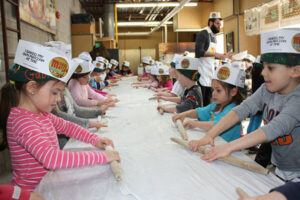This week’s parshah, Tetzaveh, describes in detail the clothing to be worn by the ancient Kohanim (priests) when they conduct rituals. Since the destruction of the temple, the role of the priests has been largely replaced by prayer. Yet specialized clothing for spiritual purposes remains, most notably tallit and tefillin worn during prayer. We wondered, along with our students, why the Torah would dedicate so much detail to clothing worn for ritual purposes and why clothing matters when we pray? Traditionally, the tallit is understood to serve as a reminder of the 613 mitzvot. A declaration of kavannah (intention) said before wrapping the tallit associates the 613 mitzvot with the number of bones, main organs, and muscles in our body. While the numerical values are not meant to be precise, the idea is that when we wrap our body in a tallit, we are focusing not just our minds, but all parts of our bodies together in the act of prayer. A parallel statement of intention before laying tefillin declares that the tefillin is laid on the head and on the arm in order to unite “the soul that is in my brain, together with my other senses and capabilities.” Both tallit and tefillin help create a fully embodied focus and mindfulness for prayer.
Clothing is one of the most basic elements of all human culture. When Adam and Chava ate from the fruit of the tree of knowledge and became fully conscious, their first act was to create clothing. We think about the clothing we wear for different purposes and contexts, and how the clothing we wear represents our intentions. By adopting special clothing for prayer, we channel the consciousness we have around clothing towards forms of spiritual mindfulness. This Shabbat, may we have the opportunity to experience clothing as a reminder of mitzvoth and mindful spiritual practice.
Shabbat Shalom,
Moreh Greg










